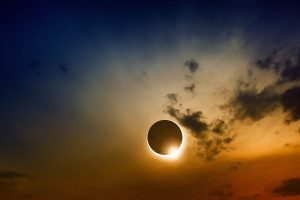On August 21st, there will be a total eclipse of the Sun. It will be the first time in history that the scientists will be able to comprehensively measure the infrared radiation being emitted from the Sun’s corona. Using two spectrometers and cameras, the images will provide valuable reference data that the scientists can use to benchmark the measurements.
NCAR (National Center for Atmospheric Research) scientists will point the specialized instruments, (the spectrometers that measure the emissions of infrared radiation and the cameras that will image light) in the near infrared and visible spectrums. The images from the cameras will provide valuable reference data that scientists will then be able to use as benchmarks in further infrared measurements. The results could help researchers better understand the structure and evolution of the Sun’s mysterious and chaotic magnetic fields.
 With a total eclipse, the moon slides directly between the Earth and the Sun. For a few precious moments, day will turn into twilight across a swath of the United States. At the precise moment, the NCAR scientists will point the specialized instruments – mounted onboard a research aircraft as well as deployed on the ground – directly at the Sun. Since the blinding light from the Sun’s face is temporarily blocked, the instruments can characterize how certain wavelengths of infrared radiation are affected by the Sun’s magnetic fields.
With a total eclipse, the moon slides directly between the Earth and the Sun. For a few precious moments, day will turn into twilight across a swath of the United States. At the precise moment, the NCAR scientists will point the specialized instruments – mounted onboard a research aircraft as well as deployed on the ground – directly at the Sun. Since the blinding light from the Sun’s face is temporarily blocked, the instruments can characterize how certain wavelengths of infrared radiation are affected by the Sun’s magnetic fields.
“The Sun has never been properly surveyed in the infrared,” said NCAR scientist Phil Judge, who is leading NCAR’s research effort. According to Judge, the August eclipse offers scientists an almost ideal opportunity to observe something entirely new.
At UKA, we are on the cutting edge of designing precision lenses for spectrometers and cameras. In this particular case, it will give scientists an advantage to expand their understanding of the Sun. However, it should also allow for further research and development of other pieces of equipment designed to further investigate our Solar System and the Universe. Employing the services of our unique in-house design, development and manufacturing facilities, you can be assured that your design will meet the specifications desired.
The Airborne Infrared Spectrometer (AIR-Spec), built by colleagues at Harvard, will observe the eclipse from onboard the NSF/NCAR Gulfstream-V (G-V) research aircraft. It will actually be chasing the eclipse in the sky. In preparation for observing the eclipse, the research team has flown practice flights, chasing the moon on occasions when it travels across the sky on the same trajectory as it will during the eclipse.
“This is a one-shot deal. If you get it wrong, you don’t get another opportunity for years,” Judge said. “So we have worked to be as prepared as possible.”
Like the AIR-Spec instrument flying on the G-V, the spectrometer on the ground is designed to observe light in the infrared spectrum, and scientists hope the measurements will complement and validate those taken in the air.
“The eclipse allows you — through a quirk of nature — to study for a brief period that far, far piece of infrared,” said Scott McIntosh, director of NCAR’s High Altitude Observatory.
According to McIntosh, if the results from these readings are satisfactory, a case can then be made to further develop other equipment
If the results from these readings are satisfactory, a case can then be made for further development of other equipment to more fully understand the effects of the Sun’s IR light on the earth.
Universe Kogaku designs and manufactures optical lenses for spectrometers and cameras, security, high tech and electronic applications. We stock 1000’s of standard lens assemblies and can custom design a solution for scanners, CCTV, CCD/CMOS, medical imaging, surveillance systems, machine vision and night vision systems.